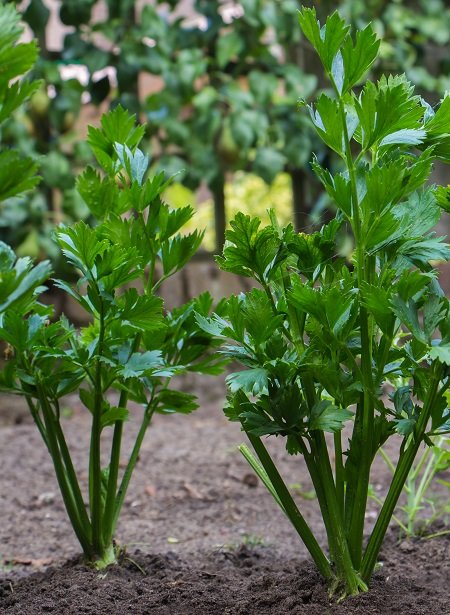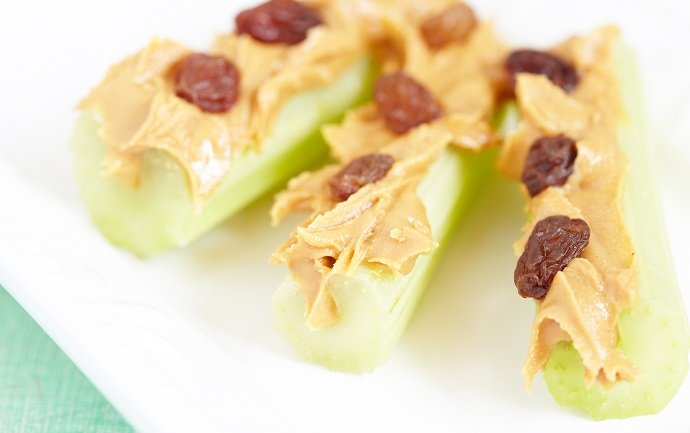
Celery is a commonly known vegetable, yet often seems to be misunderstood. From the idea that it is a negative calorie food, to that it provides no nutritional benefits, celery’s place in the diet seems to have been exaggerated or underestimated. Finding where celery stands can help determine if celery is the vegetable for you.
What does celery have to offer?
Celery, Apium L., is from the Apiaceae (carrot) family, and is therefore related to carrots, parsley, parsnips, fennel, and even poisonous hemlock. Celery is 95% water and provides 16 calories per 100 grams (6 calories/medium stalk). In that 100 grams, celery offers 3 grams of carbohydrates (1.6 grams of that as fiber), <1 gram protein, and relatively no fat. Celery does offer some calcium, magnesium, phosphorus, potassium, sodium, and vitamins A, K (K1), C, and most notable of the B-vitamins, folate (B-9).
Celery has other unique health benefits that can help reduce oxidative stress and inflammation. Due to celery’s phytochemicals, antioxidants, and non-starchy polysaccharides, celery has been shown to have anti-inflammatory and oxidative damage protection benefits. Therefore, it is thought that the inclusion of celery in your diet can help prevent cancer and chronic disease.
You may have heard that eating celery, or other so called negative calorie foods, such as lettuce and cucumbers, can burn more calories (via digestion)than they give, equaling weight loss. Truth be told, there is no evidence for this. While they do provide fiber, which can help with satiety, they still contribute more calories than are used to digest them. If eating a medium stalk of celery you will take in 6 calories, but only burn about 1-2 calories digesting it. Not negative calories, but still delicious and nutritious.
Proceed with caution
Even with all the positives of celery, it should be noted that some people are allergic to this vegetable. In Europe it is considered one of 14 major food allergens that must be declared in ingredient lists, much like peanuts. Celery antigens can resist heat and processing and those with the allergy must avoid any products made with celery.
Celery can cause photosensitivity, rashes, asthma, and even anaphylaxis. Celery stem (stalk) is usually what causes the allergic reaction, but a reaction can also occur from celery oil and root. Those allergic to mugwort and birch pollen often suffer from a celery allergy as well.
Back in the day
By the 17th century celery was beginning to be cultivated and used as a food in Europe. Prior to that (before 850 B.C.), wild celery was used in Mediterranean cultures, most often for medical purposes. There is even mention of celery (by the name of selinon) in Homer’s Odyssey. There was some belief among Greeks and Romans that celery (and parsley too) could ward off a hangover…Bloody Mary anyone? (Although celery placed in a Bloody Mary was not actually ‘a thing’ until the 1960’s)
Let your garden grow
So if you are not allergic to celery, and perhaps inspired by its history, or really love the taste of it (or of Bloody Mary’s) you can try your hand at growing the stuff. To start celery seeds indoors, do so 10 weeks before the average last frost, and after a night of soaking to help them germinate.

When planting outside, celery should be planted 12” apart and when growing season temperatures remain between 55° and 70°F. The two imperative things celery needs in the garden are nitrogen and water. Be sure to add organic, nitrogen rich compost or fertilizers to your garden. Rotating your garden with N-fixing plants, such as legumes, is also useful.
Watering is critical for celery, as it is mostly water and does not have an affinity for heat. Mulching can help retain moisture in your soil, but celery must be watered consistently. While celery can be a bit water intensive, especially as temperatures creep up, there are ways to use water efficiently. Catching rainwater and reusing it to water plants is a great way to accomplish this.
For more ways to catch rainwater and make it useful in the garden, click here: https://www.permaculturenews.org/2016/10/21/gardens-arent-just-plants-else/
Celery is typically ready to harvest between 60- 90 days depending on the variety. Look for stalks that are above 8” tall and are a darker green. The darker the stalk is the more nutritional value it has.
During any part of the growing season don’t forget to look for pests and disease in your garden. Typical pests that affect celery are cutworms and aphids (and its relatives). To ward of aphids and family, invite predatory insects into your garden by planting attractants to invite them in. To stop cutworms, it’s best to sprinkle a little diatomaceous earth around your plants. Reducing pests will also reduce the diseases they can bring with them.
If you still need some convincing on why you should plant your own celery, or any garden vegetable, here is another reason to consider. By planting, cultivating, and harvesting your own food, you reduce the possibility of ingesting unwanted constituents from pesticides, etc. Each year the Environmental Working Group (EWG) releases its list of produce that contains the highest pesticide loads based on USDA testing. Foods on this list are suggested to be purchased if from organic sources or to grow your own.
To learn more about this and other food additives, click here: https://www.permaculturenews.org/2015/01/19/varieties-additives-and-sourcing-whats-happening-with-your-food/
Now you’re cooking
While celery is delicious on its own, with its crisp, refreshing crunch, it may not be as exciting of a dish as you prefer. If you feel the need to dress celery up, give it a bit of a twist with the recipes below.
Simple Celery and Almond Salad
By Worker Bee
As featured on Mark’s Daily Apple website
Ingredients:
1 bunch (12-15 stalks) celery, plus leaves
1 cup sliced or slivered almonds
1/4 cup olive oil
2 teaspoons lemon juice
1/4 cup roughly chopped parsley
Salt and pepper
Directions:
Chop the celery stalks and leaves into bite-sized pieces.
Mix together with almonds.
Whisk olive oil, lemon juice, parsley, and a pinch of salt and pepper together in a small bowl.
Drizzle dressing on top of salad and mix well.
Makes approximately 4 servings
And for the little ones in your household…

Ants on a log
Ingredients:
1 bunch of celery with leaves removed and stalks cut into 4” pieces
Almond butter (2T/celery piece)*
Raisins (6/per celery piece)
Directions:
For each celery piece, spread the almond butter into the grooved part of the celery.
Place raisins on top of almond butter in a row with a little space between each one. That’s it. Now enjoy.
This is a great recipe for little hands to make themselves (minus the cutting of the celery). You can even add a dash or two of cinnamon on top just for fun.
*For those with nut allergies: cream cheese, ricotta cheese, guacamole, or smashed bananas can be used in place of the almond butter.
Celery may not actually provide negative calories or truly cure a hangover, but it does provide the benefits of fiber, hydration, and possible disease fighting compounds. As long as you give it a little TLC and plenty of water, celery can become a top crop in your garden. Celery is great on its own or as an addition to any meal. So celery up and crunch on!
References:
Aggie Horticulture. Texas A&M Agrilife Extension. Celery First Used as Medicine. https://aggie-horticulture.tamu.edu/archives/parsons/publications/vegetabletravelers/celery.html
Anaphylaxis Campaign. December, 2014. Anaphylaxis.org. Factsheets. Celery Allergy: The Facts. https://www.anaphylaxis.org.uk/wp-content/uploads/2015/06/Celery-version-9-formatted-with-changes-to-terminology-re-pollen-food.pdf
Dailey, K. March 15, 2013. BBC News Magazine. Who, What, Why: Can foods have negative calories? https://www.bbc.com/news/magazine-21723312
Engels, D. October 21, 2016. Permaculture Research Institute. Gardens Aren’t Just for Plants, So What Else Is There? https://www.permaculturenews.org/2016/10/21/gardens-arent-just-plants-else/
Environmental Working Group. 2016. EWG.org. https://www.ewg.org/foodnews/index.php
Haworth, C. January 19, 2015. Permaculture Research Institute. Varieties, Additives and Sourcing: What’s Happening with your food? https://www.permaculturenews.org/2015/01/19/varieties-additives-and-sourcing-whats-happening-with-your-food/
National Nutrient Database for Standard Reference Release 28. May, 2016. United States Department of Agriculture. Agricultural Research Service. Food Search. Basic Report: 11143, Celery, raw. https://ndb.nal.usda.gov/ndb/foods/show/2914?manu=&fgcd
The Old Farmers’ Almanac. 2016. Celery. Planting, Growing, and Harvesting Celery. https://www.almanac.com/plant/celery
Thomas, L. 2017. News Medical Life Sciences. Celery Allergy. https://www.news-medical.net/health/Celery-Allergy.aspx
Worker Bee. August 16, 2009. Mark’s Daily apple. Recipes. Simple Celery and Almond Salad. https://www.marksdailyapple.com/simple-celery-and-almond-salad/












